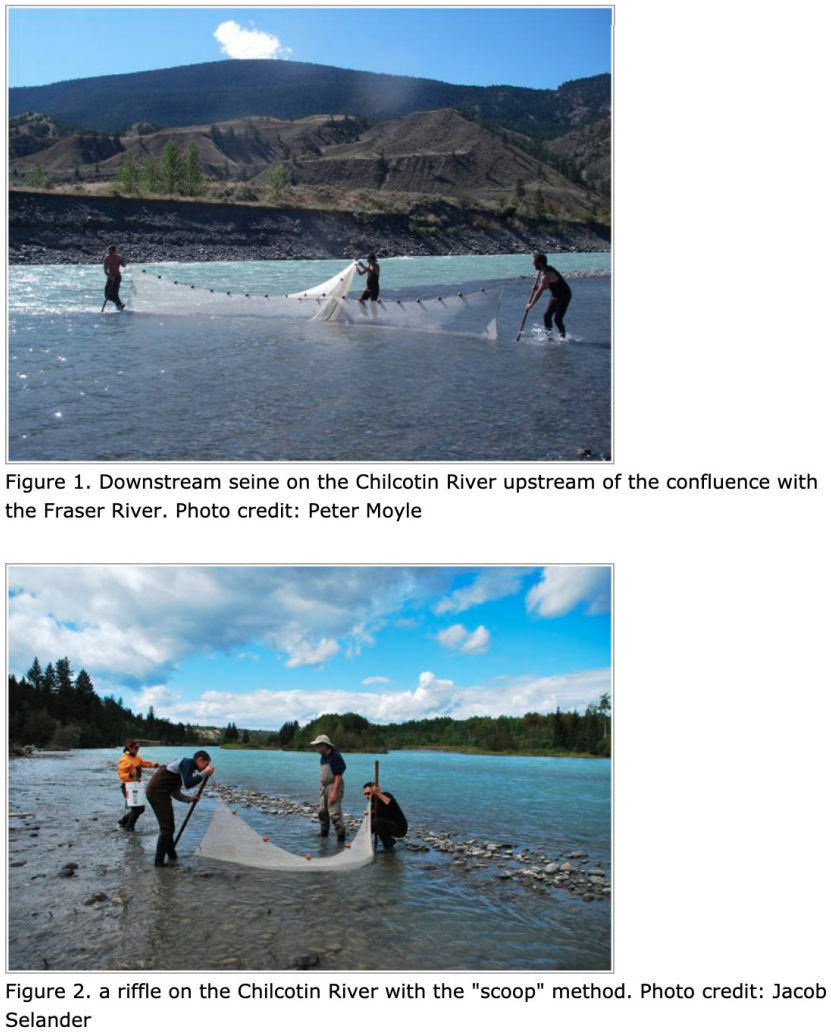Seining in calm water with uniform mud, sand, or gravel substrate is an ideal situation. Although mud can be difficult to walk through, the absence of current and large cobbles and/or debris make a good seining environment. Of the 56 seines that the fish crew pulled on our trip, less than 5 were in such ideal conditions. The rest of the times we had to compromise our seining techniques to accommodate currents of varying velocities, large cobbles and/or debris in our paths, and/or the lack of a proper beach or bank on which to land the seine.
Current adds complexity to handling the seine and walking it through the channel. It takes almost no effort at all to open the seine while moving in an upstream direction; the bag at the cod end opens like a charm as the force from the water pushes through the back of the seine. However that same force (especially from high-velocity water) creates immense drag and makes pulling the seine through the water very difficult. The issues facing a downstream seine are exactly the opposite. Pulling the net isn't difficult at all and the current gives the net-handlers a boost that allows them to cover more longitudinal distance very quickly. However getting the net into the proper position to catch fish takes one extra person and another degree of communication between all three net-handlers. The extra person is responsible for maintaining the integrity of the cod end in the presence of the downstream current. S/he must make sure the lead line and float line do not overlap any other section of the net while the current pushes everything downstream. S/he must also time his/her release of the cod end at the appropriate time so that it will remain in the proper shape to catch fish while the two people at the ends of the net move quickly downstream together. The cod end cannot be released early otherwise it may force fish past the ends of the seine and out of the net (Figure 1).
Fish movement also factors into the upstream/downstream issue. Most fish may move upstream or down lower in the water column under cover when spooked. We tended to catch more, larger fish in our downstream seines and more, smaller fish in our upstream seines. Mesh size is also important in determining the types of fish that can be caught in a particular seine. Early on, we noticed we were losing the smaller whitefish and sockeye through the mesh of our large 30-foot seine (mesh size % inch). After sampling a few of the same areas with the 10-foot seine (mesh size 1/8 inch), and catching many more sockeye, whitefish, and juvenile rainbow trout, we realized how our sampling method was causing a bias in the relative abundances and sizes of fishes we were observing. There were likely many more juvenile sockeye and rainbow trout and small whitefish in our sampling areas than were observed with our sampling methods.
Finally, some areas (places with steep cut banks, riffles running through the middle of islands, and in pools in Big Creek) were so far from ideal seining habitat that we resorted to the "scoop" method with the 10-foot seine (Figure 2). This unconventional method involves two people holding the seine stationary against a downstream current while a third spooks fish from upstream into the net. As soon as the people holding the net witness fish in the net, they must perform the scoop: lifting up the lead line in unison without letting the float line dip into the water. We experienced varying degrees of success with the scoop method from zero fish along the banks of the island at site 2, to a couple large Chinook and adult rainbow trout in pools in Big Creek.
All of these issues illustrate how the sampling method must be adapted to the environment in which the sampling is occurring in order to be successful. Additionally, communication among the samplers and a consensus understanding of the procedures make for smooth data collection.

